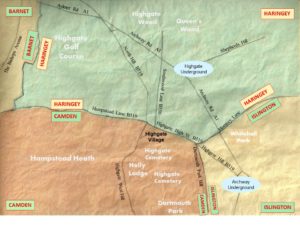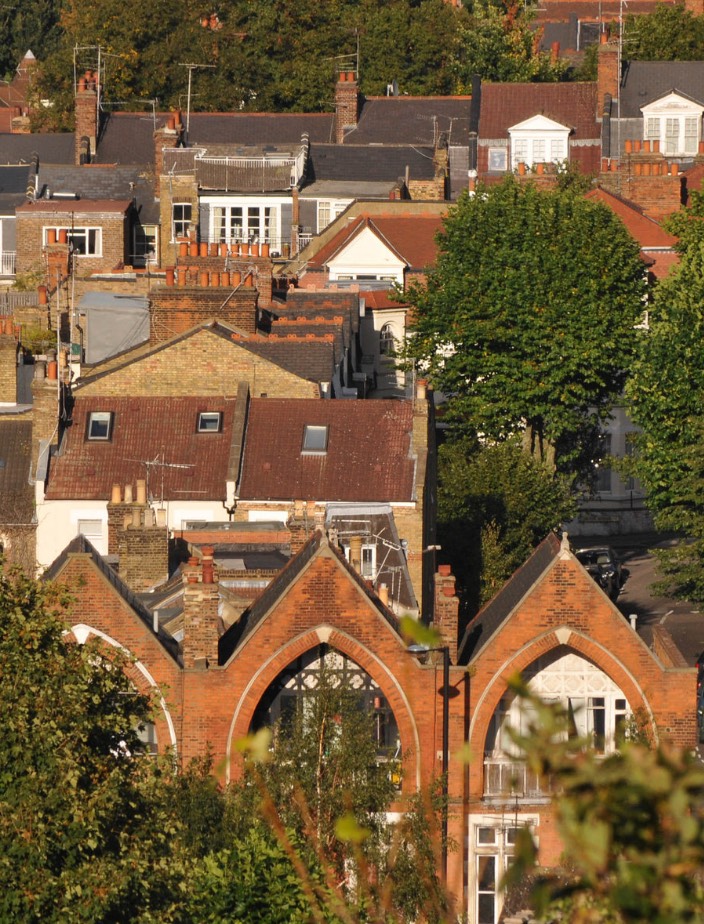A 21st Century home in a Conservation Area
Highgate falls within four boroughs – Barnet, Camden, Haringey and Islington. Each of these boroughs has declared their part of Highgate a Conservation Area, with variations on regulations for making changes. For permitted energy efficiency measures per Borough see Planning Guidelines and Planning Regulations.
 The four Borough’s conservation areas of Highgate
The four Borough’s conservation areas of Highgate
There are also many ‘Listed’ buildings in Highgate which, together with open spaces such as Pond Square, Highgate and Queens Woods and Waterlow Park, contribute much to the character of this special village. Highgate is protected through the planning system, to pass on this heritage to future generations by means of Conservation Areas, Listings and Article 4 directions, as explained below.
Preserving the special character of Highgate does not mean that the buildings cannot be energy efficient, warm or well ventilated. Many of the homes were built for the lifestyles of previous eras, where most of the rooms would have been cold by today’s standards and have little lighting. As lifestyles evolved, houses went through layer after layer of updating with bathrooms, central heating, abundant lighting and broadband being added. Today’s next essential upgrade is energy efficiency – to maximise comfort and to minimise energy bills and carbon emissions. Getting the right advice before embarking on improvements can result in a warm and energy efficient home, whilst retaining the heritage of an historic house.
Our Hampstead Garden Suburb neighbours
The owners of homes in Hampstead Garden Suburb are constrained by the need to get permission from the Trust as well as the Barnet Council regulations. The HGS has prepared a series of guides that cover topics such as window replacement, insulation, solar panels and heat pumps including SUPPLEMENTARY GUIDANCE ON ENERGY EFFICIENCY AND GENERATION MEASURES FOR SUBURB HOMES
Conservation Areas
A Conservation Area is an area with special architectural or historic interest protected by law, and obliging owners to obtain additional planning approvals. Nearly all of the roads in this map are in a conservation area. For further details including precise borough boundaries, local listings and article 4 directions follow the links below:
The Highgate Boroughs
It can be seen that different parts of ‘Highgate’ are within different Local Authorities (and different parliamentary constituencies).
Conservation hand in hand with Carbon Reduction
To reduce carbon emissions from existing homes we either need to reduce fuel use or to generate power from non fossil sources – such as the sun and wind. Homes in Conservation and article 4 directionAreas, even Listed homes can all make changes to reduce their energy and carbon use.
Fuel can be reduced by insulating walls, floors and roofs, closing heat leakages and installing efficient heating systems, and care should be taken to choose contractors who know how to work with the original building to maintain ventilation and moisture management. Domestic renewable power can be electricity generated from solar PV, or micro wind. Renewable heat includes solar thermal panels, air source or ground source heat pumps that heat water, reducing gas bills.
Where particular measures could affect the look of a heritage home, there are always other measures that can increase comfort and reduce carbon emissions, such as siting solar panels away from the street. Any change to the appearance of homes in a Conservation Area requires planning permission, based on Government and Greater London Authority policies that are interpreted by the Local Authorities.
The Government department responsible for Planning and for Building Regulations is the Department of Communities and Local Government (DCLG). It’s National Planning Policy Framework (NPPF) states the Core Planning Principles for Local Authorities to interpret and discharge, including:
“support the transition to a low carbon future in a changing climate, ……, and encourage the use of renewable resources (for example, by the development of renewable energy)” – para 17 6th bullet
“conserve heritage assets in a manner appropriate to their significance, so that they can be enjoyed for their contribution to the quality of life of this and future generations” – 10th bullet
” To help increase the use and supply of renewable and low carbon energy local planning authorities should recognise the responsibility on all communities to contribute to energy generation from renewable or low carbon sources. They should:
– have a positive strategy to promote energy from renewable and low carbon sources;
– design their policies to maximise renewable and low carbon energy development while ensuring that adverse impacts are addressed satisfactorily, including cumulative landscape and visual impacts.” – at para 97.
The Greater London Authority is the strategic authority with a Londonwide role to design a better future for the capital. The London Plan at Policy 7.8 Heritage assets and archaeology advises each London Local Authority that:
F Boroughs should, in LDF policies, seek to maintain and enhance the contribution of built, landscaped and buried heritage to London’s environmental quality, cultural identity and economy as part of managing London’s ability to accommodate change and regeneration.
G Boroughs, in consultation with English Heritage, Natural England and other relevant statutory organisations, should include appropriate policies in their LDFs for identifying, protecting, enhancing and improving access to the historic environment and heritage assets and their settings where appropriate, and to archaeological assets, memorials and historic and natural landscape character within their area.
The Local Authorities including the Highgate boroughs of Barnet, Camden, Haringey and Islington are required to abide by these requirements. For further info for building regulations and planning policies across the boroughs in Highgate see the Sustainable Homes planning guidelines and building regulations page.

